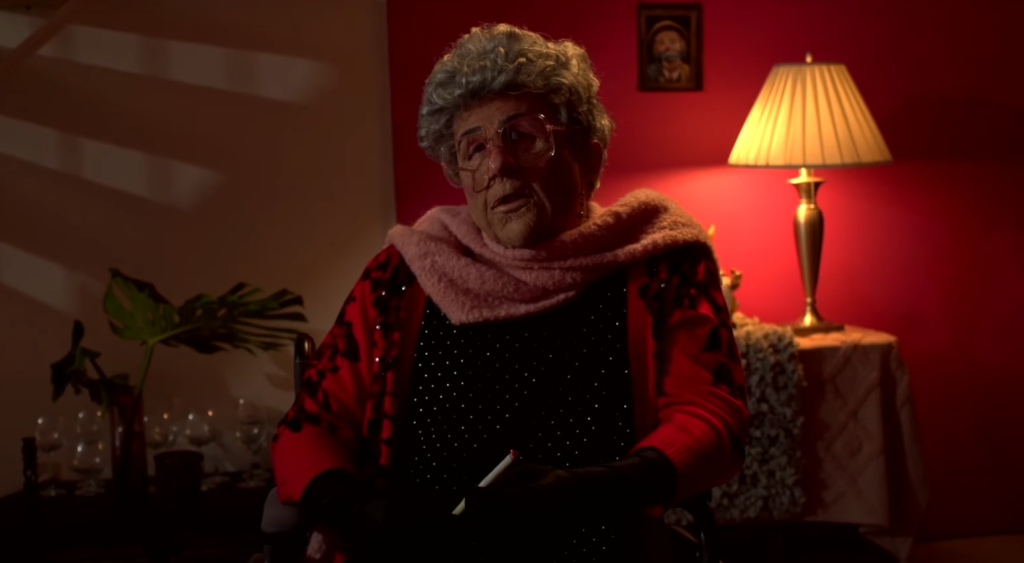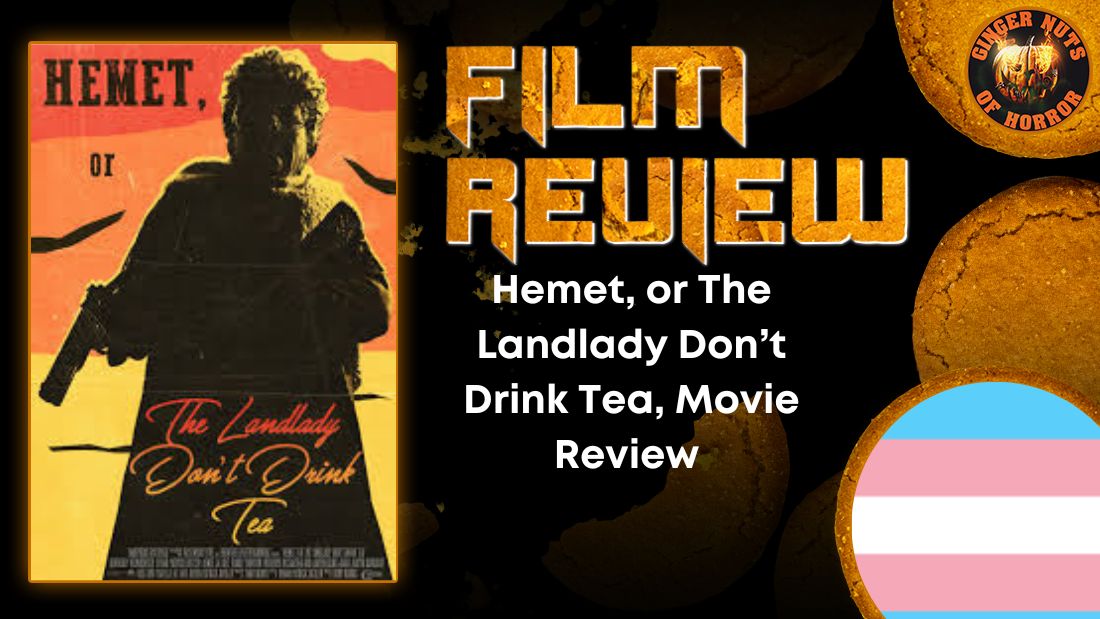Hemet, or The Landlady Don’t Drink Tea
A Horror Movie Review by Jenna Jarvis

Hemet, or the Landlady Don’t Drink Tea is a 2023 American satirical dark comedy film directed by Tony Olmos and written by Brian Patrick Butler. Butler also leads the ensemble cast that includes Kimberly Weinberger, Aimee La Joie, Randy Davison, Merrick McCartha, and Nick Young. Olmos and Butler produced the film together through their companies Rosewood Five and Charybdis Pictures. The story focuses on tenants who grapple with each other while attempting to oust their fascistic landlord.
The film is set in a fictional dystopia in Riverside County, California but was filmed in San Diego County with a microbudget in 2021. Some key aspects of the film involve capitalism and fairy tales, as well as slasher film and zombie apocalypse tropes. The film premiered in 2023 at Digital Gym Cinema for San Diego Film Week, screening at Oceanside International Film Festival and Hemet Film Festival in 2024. It was released on video on demand on November 26, 2024 where it was distributed by BayView Entertainment.
After finishing its festival run after originally screening in 2023, Hemet, or The Landlady Don’t Drink Tea, has now arrived on Tubi. Biting, blackly comic and distinctly all-American, this ninety minute story of how much more hellish landlords might become in the beginnings of a zombie pandemic offers a very different lens on one of our most saturated modern genres.
Hemet, or The Landlady Don’t Drink Tea, Movie Review
As society begins to close the schools and enforce martial law, Landlady Liz, played in a great comedic turn by the film’s writer Brian Patrick Butler, rules over the tenants in her complex with a manipulative iron fist. Eviction is a constant threat, and one that Rosie (Kimberley Weinberger) at first does everything to avoid by diligently keeping on Liz’s good side.
Directed and produced by Tony Olmos on a microbudget of £29,000 and distributed by Bayview Entertainment, Hemet was named after the Californian town, but interestingly may also refer to a female ruler of Egypt. Considering Liz’s continued references to her “followers” (tenants) who “worship” her, this also feels relevant.
The concept in taken to extremes that make most sense through a microbudget lens: what if it’s not only that humans are the real monsters, but also that the zombie epidemic will not be a real onscreen threat, or maybe even real in the way it’s being advertised? Instead of asking what if the dead rose or a person became infected and 28 days later the world was half over, it prods at a much more depressingly familiar question: how bad would things have to get before you stopped paying rent and wouldn’t it only make the rent go up?
Taking obvious inspiration from the recent western response to the COVID-19 pandemic, (though the idea began for Butler in 2018 the principal photography was completed over the summer of 2021) it just as interestingly feels influenced by the memory of AIDS and the way in which problems arriving first for society’s undesirables are easily pushed out of mind, even in circumstances as heightened as these.
If every infected potential zombie can be avoided with a car and a place to stay and seem mostly to be homeless “commie” drug users then they don’t have to be a reality accepted by those convincing themselves they’re above that. For those dangling on the edge of breadline at the mercy of a tyrannical landlady’s whims however there isn’t the same security.
The world of Hemet is populated with so many supporting characters, all strongly costumed. This is a great strength; the world created feels populated, and the characters all have unique relationships to each other. However, it would have helped to have more of them inspire some humour if not sympathy.
The heel-to-face-to-heel turn of Liz’s long-suffering daughter is one of the more interesting character conflicts of the film and one of the only ones shown onscreen but there’s no time given to linger on it. Her son who both literally eats shit (very likely a Pink Flamingos reference, but one safely delivered offscreen) and wants to be the homicidal hero of the film is introduced incredibly late for the focus the last act puts on him, but luckily the young actor is capable of shouldering this well.
Along with teasing zombie apocalypse narratives Hemet also plays enthusiastically with slasher tropes. Rosie makes for a hardened yet virtuous final girl with an interest in chainsaws. Her monster to defeat is meta-textually one of the more familiar ones in horror history: a man playing at being a woman who is also a serial killer. Happily, this does not feel leant on for transphobia, aligning far more with a pantomimic sense of humour that exists most around Liz.
In the last act of the film this tonal juggling often becomes ridiculous, balancing the grim use of the confederate flag with people being tricked into physically harming themselves in sequences reminiscent of live action Bugs Bunny shorts. It often felt almost too big to manage within a script that prior to this rarely strayed from a more grounded approach.
I welcomed the gore it brought and all of it was performed well, but I would have enjoyed seeing some of that wildness earlier in the film. Though I’m in agreement with those critics drawing comparisons to early works of the Coen brothers and John Waters, I would insist that these filmmakers always had a better grasp of integrating cartoon logic.
Despite the smooth editing, the whole movie feels grindhouse, but I needed to feel it being played more straight in the spirit of those grimy seventies movies, or more fully committing to comedy the cast were prepared to pull off. Though it has more originality and clear political takes than something like a Shaun of the Dead, that does still remain the funnier movie, as do many of the slew of zom-coms that have attempted to follow it since. It’s a crowded market, but luckily Hemet still has a point of view that feels completely fresh.
What it most invites comparison to from recent years is Jim Jarmusch’s most recent film The Dead Don’t Die. Although Jarmusch obviously nails a much funnier and more surrealist tone, this laps it in terms of coherent satire. In both, viewers familiar with the genre will worry that none of the characters of these small community settings are doing enough to prepare for how bad things might become, but Hemet offers us a reason as to why no one is able to change their status quo.
Many of them try, usually unsuccessfully. The landlady gives them more immediate hardships to worry about and the zombies aren’t dead, they’re bath salt users. Everyone dies, but only some idiots easy to look down on are going to keep taking bath salts. It evokes some of the moral panic around those testing positive for COVID after going out more than was deemed acceptable.
It’s also left unclear how much the “salties” remain themselves. In one scene, Rosie approaches a group of homeless people seeking help, and asks a woman if that’s what she is. The woman replies: “depends on the day”. We and Rosie can’t be sure if she’s joking because we just don’t know enough about these things. Later, when one of the characters has their drink spiked with bath salts, they give in to their cannibalistic urges, but for a clear purpose, and continue to maintain conversations. It seems that the “zombies” here retain their humanity no matter the new hungers they’ve been afflicted with.
I would recommend checking Hemet out on Tubi. Tony Olmos’s direction is sharp, the special effects are marvellous and it has a clear sense of style with something fun and mean to say. It also hates cops and landlords, which is always a win for me.
I had a great time watching it and am excited to see more from the creators, but more heart may have helped its darker beats land more substantially. Too many characters became protagonists of their own sections with too little to inform the audience of their character, sympathies or motivations. There was room to fill out into a much longer film or miniseries, but I’m glad that it stays instead a shorter movie with a great new take on the genre.
Further Reading
Horror movie fans looking to deepen their appreciation for the genre should definitely check out the Horror Movie Review section of Ginger Nuts of Horror. This platform is a treasure trove of insights, critiques, and discussions that resonate with both casual viewers and dedicated aficionados alike.
Firstly, the reviews are penned by passionate writers who understand the intricacies of horror filmmaking. They delve deep into the elements that make each film unique, from unsettling visuals to compelling sound design, offering a comprehensive analysis that goes beyond superficial impressions. Such in-depth reviews can enhance viewers’ understanding and appreciation of the genre, revealing layers of meaning and intention that may go unnoticed during a first watch.
Lastly, with its focus on both mainstream and indie films, the Horror Movie Review section is an excellent resource to stay updated on upcoming releases and trends in the horror landscape. For any horror buff, exploring The Ginger Nuts of Horror Review Website is an essential step toward a deeper connection with the genre.


